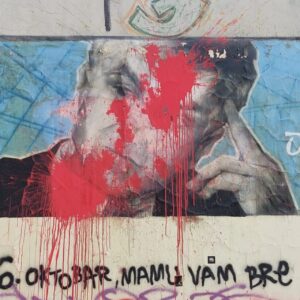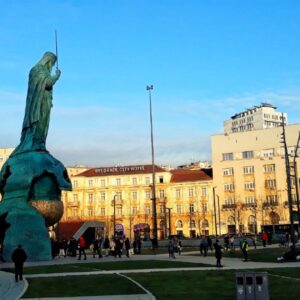

Bremen’s Elefant: Memorialisation, politics, and memory surrounding German colonialism
By Berklee Baum • March 25, 2022
In 1932, German citizens gathered for the dedication of the Kolonialelefant in Bremen. The Bremen Colonial Society created this monument in memory of the German soldiers who died in the German colonies during the First World War. As well as to glorify colonialism and bolster the neo-colonial movement (after the Treaty of Versailles had stripped Germany of its colonies in 1919). The first speaker at the ceremony was Eduard Achelis, Chairman of the Bremen section of the Deutsche Kolonialgesellschaft (German Colonial Society). In his speech, he stated:
In this solemn hour dedicated to our colonies, may the whole German people step up and […] unanimously shout to the world: Away with the events of the past, with lies and slander; we Germans demand our rights. The recognition of necessary living conditions. Immediate return of our own land, honestly acquired and honestly managed, an expensive legacy left to us by our fathers: the German colonies.
For Achelis and many others, the value of the Elefant lay not in the memory of the specific German soldiers who had lost their lives but in the reminder of the sacrifice that went into obtaining and controlling colonial land in Africa: the injustice of that land being taken away. A specific version of colonialism was publicly displayed through the Kolonialelefant: colonialism was a worthy venture that brought glory and prosperity. The city’s actions followed this version of colonial memory. The National Socialists of Bremen established the town as the ‘Capital of the Colonies’ after the statue’s dedication, and in 1938, a convention that brought together all of the German colonial organisations was held in Bremen.
Six decades later, the Elefant underwent a second dedication – this time it was dedicated as the Anti-Kolonial-Denk-Mal (Anti-Colonial Monument). Before the ceremony, the Elefant was wrapped in fabric ‘chains’ of racism and colonialism, which were cut away during the ceremony. Speeches were given that grieved the atrocities of German colonialism, and a plaque was unveiled, which provided a history of German colonialism and the monument’s problematic creation. The plaque also highlighted the reason for rededicating the memorial: ‘This monument is a symbol of the responsibility we have inherited from history.’ Many Bremen-based organisations were involved in the rededication process, and other efforts to campaign for greater awareness of Germany’s colonial past. The fond memory of German colonialism that prevailed in Bremen in the 1930s was replaced by a memory of German colonialism shrouded in racism and violence.
The Elefant is both a reflection of and exception to German memorial culture. Like the Elefant, German colonial memorials created before the Holocaust glorified colonialism. After the Holocaust, when genocide was defined and criminalised, there was a gap in German colonial memorialisation. No longer were memorials glorifying colonialism erected, and colonial monuments that already existed, including the Elefant, were largely left to decay.
In the 1970s and 80s, the anti-apartheid movement swept across Europe, bringing awareness to the lasting impact of colonialism. Citizens in Bremen began to analyse how the city was responsible for the disastrous situation in South West Africa, particularly in Namibia (then controlled by South Africa), a former German colony. It is at this point, Bremen began to be an exception to overall German memorial culture, starting with the creation of initiatives to support Namibia and its independence movement. In 1980 the Centre for African Studies at Bremen University co-founded the Namibia Project, the purpose of which was to promote education and improve the legal system in Namibia. This programme spread beyond the University, creating connections with political groups across the Bremen area. In 1989, Bremen joined the Europe-wide campaign ‘Cities against Apartheid’. At the time, movements against colonialism and apartheid were yet to gain momentum in Germany. Germany’s official policy was cooperation and even friendship with South Africa while ignoring apartheid and the illegal occupation of South West Africa and, in some sense, supporting the occupation due to lobbying by the German minority living in South West Africa. Bremen’s efforts to improve the situation in South West Africa were accompanied by initiatives for greater awareness of Germany’s colonial past. Activist individuals and organisations in Bremen wrote educational materials for schools and articles for newspapers and academic journals while also organising awareness campaigns in the city. These decolonisation efforts led to a renewed focus on the Elefant statue, the very existence of which was a symbol of Bremen’s former support of colonialism. By rededicating the Elefant, Bremen confronted a colonial legacy that the rest of Germany had been ignoring for decades. The Elefant remains one of the only anti-colonial memorials in Germany – evidence of the nation’s continued willful amnesia of its colonial crimes.
Works Cited
‘Treaty of Versailles’, United States Library of Congress, June 28, 1919, Part IV Section I.
‘Einweihung des deutschen Kolonial-Ehrenmals’, 7 July 1932, Ausgabe Nr. 187 Drittes Blatt, Schünemann, Bremen, quoted in G. Eickelberg, ‘Die Geschichte des Bremer AntiKolonialDenkmals’, Feb. 2012.
The Plenipotentiary of the Free Hanseatic City of Bremen for Federal Affairs, Europe and Development Co-operation, ‘Co-operation Bremen – Namibia: A Responsibility Posed by History’ (Bremen, 1999).
‘Als Bremen „Stadt der Kolonien” sein wollte’, WK Geschichte [Bremen], (27 May 2018).
Bremen State Office for Development Co-operation, ‘Vom Kolonial-Ehrenmal zum Anti-Kolonial-Denk-Mal’ (Bremen, 2004).
Bremen Parliament, Entschließung der Stadtbürgerschaft vom 19.9.1989, ‘Die Stadtbürgeschaft begrüßt die 1986 in Den Haag gestartete europäische Aktion “Städte gegen Apartheid” und schließt sich ihr an’, September 19, 1989.



